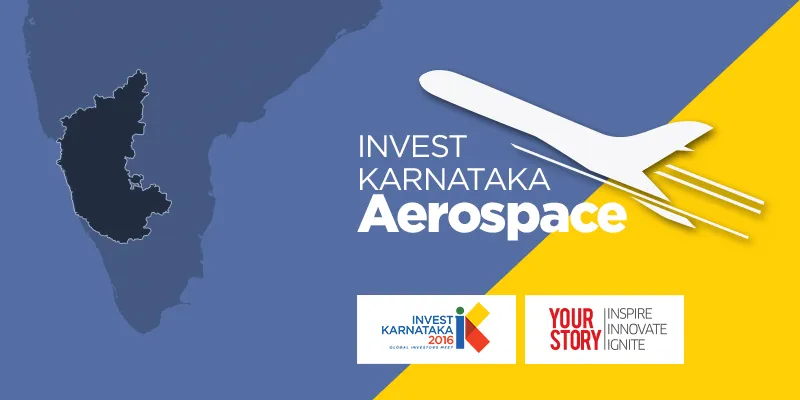VCs are not the right people to go to, say startups in the aerospace and defence sector
Their world operates outside the orbit of GMVs and high valuation numbers. The startups in the aerospace and defence sector are like the stars in the sky. Always there, but visible only in the night. The bright light of billion dollar funding that shines upon the market favourite e-commerce sector makes it difficult to spot them. But they are there, not one, not two but several that are part of the nearly 550 small and medium industries catering to the space sector in India.

Thus when four such startups came together on a single platform it was no less a rare cosmic phenomenon. And when they indulged in some good humour ‘VC bashing’, it was an indication that the startup ecosystem sits up and take notice.
India as a space economy is only a one-billion dollar one compared to $300 billion global space economy. That's where disruption should happen.
At Deftronics, a two-day event organised by the India Electronics and Semiconductor Association (IESA), the premier trade body representing the Indian Electronic System Design and Manufacturing (ESDM) industry, and Nasscom along with Roland Berger in Bengaluru on August 4 and 5, the panel on aerospace and defence startups gave unique insights into the challenges faced by these startups. The biggest of which was, no prizes for guessing, availability of funding.
New thinking needed
Parag Naik, CEO of Sankhya Labs, a veteran in comparison to the younger ones on the panel, did not mince words while presenting the funding scenario for them. “I have been in the startup space for 17 years now, and I believe things, the more they change the more they remain the same. There’s a lot of platitudes, but the truth is nobody knows how to value IPR businesses in India. It’s like a painting, the value of it is in the eyes of the beholder. Thus for startups like us, we have to look for strategic investors who understand the business. In India, we do not have people like Andrew Horowitz who’ll sign a cheque and say go ahead.”
Another interesting point he noted was that
People in India are always looking for a precedent and that, it so happens, is the mentality of a follower and not an innovator.
Anand Madanagopal, Founder and CEO of Cardiac Design Labs, which was the only healthcare startup among space and communications startups on the panel, has found himself the angel route after pursuing VCs under the false impression that that’s where his nirvana lay. He said,
“I think angel rounds in India are sweet now. This is the best time when you reach out to the right people a lot of things can happen.”
However, he added, “What you do about valuation…that I think is the Nataraja dance you have to do well. The better the dance, the better the story, then you can get away with anything.”
According to Anand, VCs are not the ones to bet on. “They are at a stage where they want something that is proven, and can be scaled up to allow them to exit. Don’t go to them. You are wasting their time as well as yours,” he advised.
For Parag, the funding process is a funny one. “You don’t get funded because of your technology or team, you get funded because the guy (VC) thinks you are capable of it, which could be different from the reality,” he said.
Interestingly, Arvind Lakshmikumar, CEO of Tonbo Imagining, who was moderating the session questioned whether most VCs understand core technology investment in India at all.
Narayan Prasad, Co-founder of Dhruva Space, revealed that funding is a tough road. He said,
“Space is like a chicken and egg situation. The first question we get asked is how many customers have signed up. That’s not how space sector will work in India.”
He added that many investors admit that this is not a space that they understand. Neither the market, scale, nor sustainability of it in the Indian scenario.
Narayan, whose startup is looking to engineer small satellite constellation for commercial remote sensing as an end product, is solving this problem by putting his money initially and proving there is something flying in space that is end-to-end developed by a private company in India. “I put my money on breaking the ice otherwise two-three people in your team will be deployed full-time on chasing investors,” he added.
The sprightly CEO of Astrome Technologies, Neha Satak, said space business is tricky and her approach has been to raise money in phases. “Right now, we are developing our core technology, so we are creating the value up front. We want to create a business model where we take money, create value, and monetize and move ahead to the next phase,” she said.
Astrome Technologies is being incubated at IISc, and Neha’s vision is to launch micro satellites in lower-end orbit to provide location-free internet not just in India but to most of the developing countries in the world.

Earlier in the day, the Chief Guest of Honour RV Deshpande, Minister for Large & Medium Industries & Infrastructure Development, Govt. of Karnataka, said that the state wanted to “encourage women entrepreneurs and first generation businesspersons with incentives and guidance. It is important that Deftronics should become a platform where it can attract investments going forward.”
Mindset a big hurdle
In the last five to 10 years, every major asset-heavy industry whether it is logistics, entertainment, healthcare or transportation, have all been disrupted with technology platforms. Defence and aerospace is the last bastion of asset-heavy industries that remains to be disrupted.
“In the 60s and 70s, new tech development that happened in defence industry found its way to the commercial world,” said Arvind. Today, the power of consumer electronics hardware far surpasses what exists in the military world. He added,
“Your smartphone, for instance, has more electronics horse power than what’s there in a 155 mm Howitzer or a UAV. So the fact that commercial technology has the power to disrupt traditional military systems means that there are going to be more startups in the A&D space.”
The question that follows is what can the government do to promote these startups and showcase them to the world?
Right now there is no reach, the only impression people abroad, and even here, have is that there is only one entity, Isro. There were suggestions like providing a booth (which are otherwise very expensive) at the biggest space event in India, the Bangalore Space Expo. Other suggestions included competitions where Isro could get the three best ideas and take them to the International Astronautical Conference to showcase their talent and technology.
The panelists also spoke about easing norms when it came to technology transfer in terms of licensing costs. “A lot of early stage funding is available for development of certain technology at Nasa. For example, Nasa puts out a call for proposals, startups apply and get around $ 100,000 to 200,000 as phase one money. Once they pass the assessment, they move on to the second phase,” says Neha, who studies in the US and came back to India with a dream of setting up a space company here.

Narayan brought out the issue of a cultural mindset in India, where there is still a long way to go as far as startups are concerned. “Even if you are a two-person company working out of your backyard, you are considered an industry. So the word industry is universal,” he says.
They all agreed that there was no dearth of funds, indicating to the Rs 10,000 crore tech fund announced by the government, but it is the deployment that is a challenge. “That’s because they cannot evaluate the validity of the technology,” Parag said, adding, “Not just that, it is also the risk appetite of people who manage these.” He should know what he is talking about. It took him a whole year to actually get money from the government after numerous trips to Delhi.
There is a certain disbelief that an Indian startup can do what traditionally a north American or an Israeli startup would do. And the local mindset is a bigger problem. Anand of Cardiac Design says at a conference once he was asked whether he’s sure some of the big companies did not have the technology he was talking about.
Unless this mindset changes the efforts by new startups in aerospace and defence may well end up in the black hole of the power corridors.







